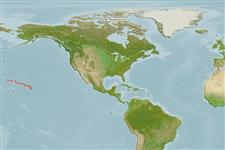Environment: milieu / climate zone / depth range / distribution range
Ecología
marino asociado a arrecife; rango de profundidad 1 - 217 m (Ref. 58302). Tropical; 27°N - 16°N, 175°W - 154°W
Eastern Central Pacific: known only from the Hawaiian Islands and Johnston Atoll.
Tamaño / Peso / Age
Maturity: Lm ? range ? - ? cm
Max length : 17.0 cm TL macho / no sexado; (Ref. 9710); common length : 14.0 cm TL macho / no sexado; (Ref. 583)
Espinas dorsales (total): 11; Radios blandos dorsales (total): 13-14; Espinas anales 4; Radios blandos anales: 9. Body with alternating about stripes of red and silvery white; head red; operculum with silvery reflections, a white streak from above edge of upper jaw to the corner of pre, and a narrow white band on posterior edge of preopercle. Five oblique scale rows on cheek; body depth 2.7-3.1 in SL; head length (HL) 2.55-2.75 in SL; snout length 3.85-4.15 in HL; interorbital width 4.8-5.15 in HL; maxilla extending from below front of the pupil nearly to center of the eye, upper jaw length 2.55-2.8 in HL; premaxillary groove at least to a vertical at front edge of the orbit; rounded anterior end of nasal; medial margin of nasal bone spineless; small nasal fossa without spinules on margin; slight ridge along the upper edge of suborbital bones smooth anteriorly, slightly serrate below posterior part of eye; preopercular spine, 5.4-7.1 in HL; 2 opercular spines (1 specimen with a large opercular spine), the lower 1/2 to 2/3 length of the upper spine; 4th dorsal spine usually longest, 2.2-2.55 in HL; 3rd anal spine 1.5-2.05 in HL (Ref. 27370).
Inhabits seaward reefs below the surge zone, common near caves and ledges (Ref. 9710). Feeds mainly on crustaceans.
Life cycle and mating behavior
Madurez | Reproducción | Puesta | Huevos | Fecundidad | Larva
Randall, J.E., 1998. Revision of the Indo-Pacific squirrelfishes (Beryciformes: Holocentridae: Holocentrinae) of the genus Sargocentron, with descriptions of four new species. Indo-Pac. Fish. (27):105 p. (Ref. 27370)
IUCN Red List Status (Ref. 130435)
Threat to humans
Harmless
Human uses
Acuario: Comercial
Más información
ReferenciasAcuiculturaPerfil de acuiculturaRazasGenéticaElectrophoresesheritabilidadEnfermedadesProcesamientoNutrientsMass conversion
Herramientas
Special reports
Download XML
Fuentes de Internet
Estimates based on models
Preferred temperature (Ref.
123201): 6.1 - 13.9, mean 8.7 °C (based on 5 cells).
Phylogenetic diversity index (Ref.
82804): PD
50 = 0.5000 [Uniqueness, from 0.5 = low to 2.0 = high].
Bayesian length-weight: a=0.01622 (0.00774 - 0.03400), b=2.97 (2.80 - 3.14), in cm total length, based on LWR estimates for this Genus-body shape (Ref.
93245).
Nivel trófico (Ref.
69278): 3.5 ±0.3 se; based on diet studies.
Resiliencia (Ref.
120179): Alto, población duplicada en un tiempo mínimo inferior a 15 meses (Preliminary K or Fecundity.).
Fishing Vulnerability (Ref.
59153): Low vulnerability (10 of 100).
Nutrients (Ref.
124155): Calcium = 69.1 [27.1, 290.0] mg/100g; Iron = 0.59 [0.24, 1.82] mg/100g; Protein = 18.4 [17.2, 19.6] %; Omega3 = 0.182 [0.077, 0.420] g/100g; Selenium = 45.5 [25.6, 86.1] μg/100g; VitaminA = 71.7 [27.1, 201.5] μg/100g; Zinc = 2.04 [0.84, 3.79] mg/100g (wet weight);
